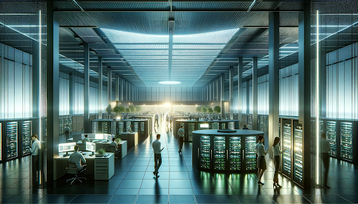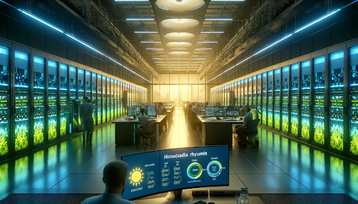In the high-stakes world of network operations centers (NOCs) within data centers, the spotlight is increasingly on an often-overlooked aspect of workplace design: lighting.
Not just any lighting, but human-centric lighting (HCL), an innovation that goes beyond simple illumination. HCL positively affects operators' health and productivity.
This article explores how adopting HCL in data centers can significantly enhance the well-being and productivity of NOC operators, promising a better workplace environment and improved operational efficiency.
Understanding human-centric lighting (HCL)
At the heart of human-centric lighting is the goal of mimicking our natural light cycle, which changes in color, temperature, and brightness over the course of the day. These light cycles correspond with our internal biological clocks, which is crucial for NOC operators who often work irregular shifts.
Such shifts can lead to insufficient sleep, increased fatigue, and high stress levels. Traditional lighting, with its constant and uniform output, is not suitable for these challenges. In contrast, HCL is a flexible system that adapts to human needs, mitigating the health risks associated with prolonged exposure to artificial light.
The impact of light on human well being: A scientific perspective
Lighting carries importance that extends far beyond practical functionality; it is a key determinant in maintaining emotional health, mood, and productivity.
Data center workers, for example, often work night shifts and sleep during the day, which disrupts natural light cycles. Exposure to natural light is linked to good sleep quality, mood stability, and improved work performance. Conversely, poor-quality artificial light can impair sleep, reduce mood, and decrease productivity.
Circadian rhythms, which regulate our sleep-wake patterns, are directly affected by light. Adapting lighting to these rhythms is vital for enhancing operators' well-being, mindset, and health, as well as their speed of response and decision-making.
Illuminating the challenges for NOC operators
NOC operators face unique challenges due to their irregular work schedules, which deviate from typical work routines. Disrupted circadian rhythms, increased fatigue, and psychological stress are common issues. Poor lighting exacerbates these problems, leading to issues like eye strain and further disrupting sleep habits.
The bright benefits of HCL in NOCs
The human-centric lighting concept offers numero conducted in office settings has shown that adjustable lighting systems, which vary throughout the day, can boost sleep quality and mood.
These findings suggest that similar benefits could apply to NOCs, which operate 24/7 and require constant attention, even during night shifts. These insights highlight the potential to enhance operator well being and performance in these critical environments.
This not only promotes operators' well-being, but also translates into measurable performance enhancements. For instance, it can lead to greater vigilance, fewer errors, and better cognitive functioning.
Research published in the journal 'Sleep Health' conducted in office settings has shown that adjustable lighting systems, which vary throughout the day, can boost sleep quality and mood.
These findings suggest that similar benefits could apply to NOCs, which operate 24/7 and require constant attention, even during night shifts. These insights highlight the potential to enhance operator wellbeing and performance in these critical environments.
Implementing human-centric lighting: Considerations and examples
Adapting HCL in NOCs involves a well-planned and customized approach. Key steps include:
- Assessing the current lighting environment
- Incorporating natural light
- Selecting flexible, high-quality lighting systems
While first-hand examples from NOCs are still limited due to the novelty of this approach, the benefits seen in office environments and other sectors form a strong foundation.
Similarly, dynamic lighting adaptations, which are adapted based on the time of day, have shown improvements in well-being and productivity, indicating likely performance gains in NOCs as well.
A brighter future: Conclusion and next steps forward
Human-centric lighting systems in data centers are a crucial innovation. They not only improve operator compensation but also enhance productivity and operational efficiency.
For data centers aiming to lead in workplace innovation, the steps are clear: perform a comprehensive lighting audit, consult with lighting experts, and pilot HCL systems before full-scale implementation.
Investing in HCL is not just a financial commitment, but an investment in people, who are essential to the successful operation of a data center. As our lives become increasingly dependent on the digital environment, it is imperative that the physical environment keeps pace with this development.
Human-centric lighting joins the ranks as one of the most promising trends in modern technological advancement, bringing with it a vision for a future where people and technology work harmoniously together.



